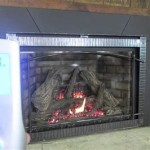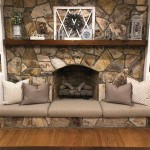Can You Tile a Fireplace? A Comprehensive Guide
The question of tiling a fireplace is a common one for homeowners looking to update the aesthetic of their living space or improve the functionality and safety of their fireplace surround. Tiling a fireplace is indeed a viable project, offering a multitude of design possibilities and practical benefits. However, it requires careful planning, proper material selection, and adherence to safety precautions to ensure a successful and long-lasting result. This article will delve into the various aspects of tiling a fireplace, covering preparation, suitable materials, installation techniques, and essential safety considerations.
Preparation is Paramount: Assessing Your Fireplace
Before embarking on any tiling project, a thorough assessment of the existing fireplace is crucial. This includes evaluating the fireplace's current condition, determining the structural integrity of the surrounding area, and understanding any building codes or regulations that might apply. The existing surface may need significant preparation before any tiles are installed.
Firstly, remove any existing fire hazards or non-permanent decorations from the area. Check for any signs of damage, such as cracks, crumbling brick, or loose mortar. These issues must be addressed before tiling to provide a stable and level surface for the new tiles. If the fireplace surround is made of wood, ensure it is adequately fireproofed or consider replacing it with a non-combustible material.
Secondly, carefully inspect the area behind the fireplace. Ensure that the wall is structurally sound and capable of supporting the weight of the tiles and mortar. For masonry fireplaces, it is particularly important to check for any signs of water damage or efflorescence, which could indicate a moisture problem. Address any underlying issues before proceeding to prevent future problems with the tile installation.
Finally, research any local building codes or regulations that might pertain to fireplace tiling. Some areas may have specific requirements for the type of materials used, the installation methods employed, or the distance between combustible materials and the firebox. Adhering to these regulations is essential for ensuring safety and avoiding potential fines or complications.
Choosing the Right Materials: Tile Selection and Mortar Considerations
Selecting the appropriate materials is a critical aspect of tiling a fireplace. The tiles themselves must be able to withstand the high temperatures associated with fireplace use, and the mortar and grout must be equally heat-resistant and durable. Furthermore, the choice of materials will significantly impact the overall aesthetic of the fireplace.
When choosing tiles, options like porcelain, ceramic, slate, and natural stone are commonly considered. Porcelain tiles are known for their durability, low water absorption, and resistance to heat and stains. Ceramic tiles are another viable option, although they may not be as durable as porcelain. Slate and other natural stones offer a unique aesthetic and are naturally heat-resistant, but they may require sealing to protect them from stains and moisture. Avoid using tiles that are not specifically rated for high-temperature applications, as they may crack or warp under the heat of a fire.
The choice of mortar is equally important. Use a high-temperature mortar specifically designed for fireplace or masonry applications. These mortars are formulated to withstand the extreme heat and temperature fluctuations that occur in a fireplace setting. Thin-set mortar is often used for adhering tiles to the surface, but it is crucial to use a type that is suitable for the chosen tile material and the fireplace environment. Read the manufacturer's instructions carefully to ensure proper mixing and application.
Grout is used to fill the spaces between the tiles. Select a grout that is both heat-resistant and stain-resistant. Epoxy grout is a durable and water-resistant option that is suitable for fireplace applications. It is also resistant to staining and mildew, making it easier to maintain. Cement-based grout is another option, but it may require sealing to protect it from moisture and stains. Consider the color of the grout carefully, as it can significantly impact the overall aesthetic of the tiled fireplace.
Installation Techniques: Laying the Foundation for a Successful Project
Proper installation techniques are essential for ensuring a successful and long-lasting tile installation on a fireplace. This includes preparing the surface, applying the mortar, setting the tiles, and grouting the joints. Each step requires careful attention to detail to ensure a professional and durable result.
Begin by thoroughly cleaning the surface to which the tiles will be applied. Remove any loose debris, dust, or grease. A wire brush or scraper can be used to remove stubborn residue. If the surface is particularly rough or uneven, consider applying a leveling compound to create a smooth and uniform base for the tiles. Prime the surface with a suitable primer to improve adhesion. The primer should be compatible with both the surface material and the mortar used.
Mix the high-temperature mortar according to the manufacturer's instructions. Apply the mortar to the surface using a notched trowel, creating ridges that will help the tiles adhere securely. The size of the notch should be appropriate for the size and type of tile being used. Apply the mortar in small sections at a time to prevent it from drying out before the tiles are set. Press the tiles firmly into the mortar, using a slight twisting motion to ensure good contact. Use tile spacers to maintain consistent spacing between the tiles. Periodically check the tiles with a level to ensure they are aligned and level.
Allow the mortar to cure completely according to the manufacturer's instructions before grouting. Remove the tile spacers and clean any excess mortar from the tile surfaces. Mix the grout according to the manufacturer's instructions. Apply the grout to the tile joints using a grout float, pressing it firmly into the spaces between the tiles. Remove any excess grout from the tile surfaces with a damp sponge. Allow the grout to dry slightly, then polish the tiles with a clean cloth to remove any remaining grout residue. Seal the grout if necessary, depending on the type of grout used.
Safety Precautions: Protecting Your Home and Yourself
Working with a fireplace and potentially hazardous materials necessitates adherence to safety protocols. It is important to invest in personal protective equipment, ensure proper ventilation, and handle materials as per their respective instruction manuals to ensure a safe working environemnt.
Wear appropriate safety gear, including gloves, eye protection, and a dust mask, when working with mortar, grout, and tiles. These materials can be irritating to the skin, eyes, and respiratory system. Ensure adequate ventilation in the work area to minimize exposure to dust and fumes. Open windows and doors or use a fan to circulate air.
Use caution when handling power tools, such as tile saws and grinders. Always follow the manufacturer's instructions and wear appropriate safety gear. Ensure that the tools are in good working condition and that the blades are sharp and properly installed. Avoid working when fatigued or distracted. Dispose of waste materials properly. Mortar, grout, and tile scraps should be disposed of in accordance with local regulations. Do not pour these materials down the drain, as they can clog pipes.
If dealing with lead paint or asbestos, contact a qualified professional for removal. These materials are hazardous and require specialized handling. If unsure about the safety of any aspect of the project, seek professional advice. A qualified contractor can assess the situation, provide guidance, and perform the work safely and effectively.
In conclusion, tiling a fireplace is a project that can enhance the beauty and functionality of a home. By carefully considering the preparation, materials, installation techniques, and safety precautions outlined above, homeowners can achieve a successful and long-lasting tile installation that will provide years of enjoyment.

How To Tile A Fireplace My Uncommon Slice Of Suburbia
/102661017-6a23c040b71843379188b96b21ac1a08.jpg?strip=all)
How To Tile A Fireplace

Diy Projects Tiling A Fireplace Like Pro Rubi Blog Usa

Tiling A Fireplace How To Tile Hearth Homebuilding

How To Tile A Fireplace Using Encaustic Tiles Boo Maddie

How To Tile Over An Existing Fireplace Surround My Woodlands Life

How To Tile A Fireplace Even If It S Brick The Handyman Daughter

How To Tile A Brick Fireplace Jenna Kate At Home

Fireplace Makeover How To Tile Over A Surround Love Remodeled

Can You Tile A Fireplace Tiling Guide
Related Posts








